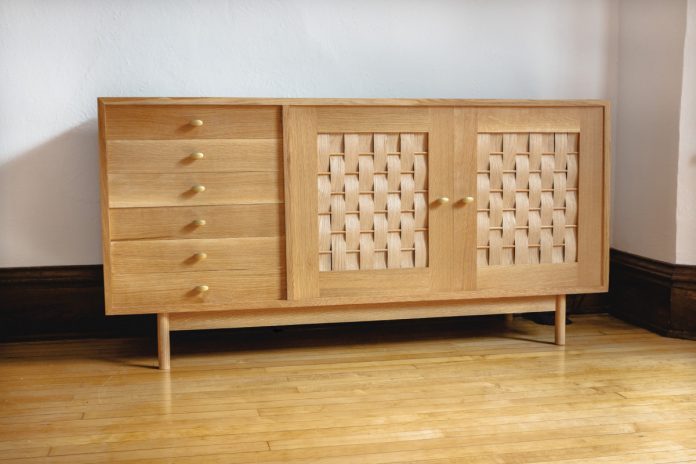We could obtain a fee if you use our affiliate hyperlinks. However, this doesn’t influence our suggestions.
Routed joints strengthened with floating tenons make a sturdy, seamless case.
Project#1903 • Skill Level: Advanced • Time: 4 Days • Cost: $350
This credenza was constructed for my eating room to accommodate overflow dishes, desk linens and the remainder of our fancy accouterments that solely come out throughout holidays. It’s constructed virtually solely out of quartersawn white oak, except for the maple drawer sides and pink oak legs. With a big cupboard on one aspect and a half-dozen drawers on the opposite, there’s room for almost all the things.
The drawers are made with a lock miter router bit. It’s one in all my favourite methods to batch out drawers that look good and are sturdy sufficient for on a regular basis use. The doorways are a frame-and-panel development, with a panel constituted of “woven” veneer and dowels. This provides the doorways some fascinating texture and a mid-century vibe.
Finally, the bottom is constituted of the offcuts paired with oak dowels for the legs. The credenza is completed with a number of coats of tinted Danish oil and buffed with wax for a satiny end that’ll maintain as much as common use in our eating room.
Cutlist

 Start with the Miters
Start with the Miters

1-2. Miter the ends of every panel with a 45° miter bit. Line up the sting of every panel with a straightedge underneath it.
First issues first: mill your lumber, joint your edges and glue up your panels. I used my monitor noticed for lots of this work—it’s my go-to for making exact cuts on massive items of lumber. I used it to chop all of my panels to size and as a stand-in for a jointer.

Cut in a number of passes, leaving only a hair for the ultimate move.
Once your case panels are reduce to dimension, it’s time to make your miters. The miters are made with a 45° router bit. The panels are 7/8” thick, so that you’ll have to ensure you have a big sufficient bit miter bit to chop these miters. Many miter bits prime out at 5/8” materials thickness, however there are a handful of bits made for thicker materials–as much as 1 1/4” thick. That’s the one you need for this mission.

3. Reinforce the miters. I laid out the Eight mortises 1/4″ from the within fringe of the miter. The fence on the Domino is ready to 45°.
The key to those miters is a straight reference edge for the router bit; I used a scrap of MDF. Cut the miter in a number of passes, I depart about 1/32” for my final move to ensure I can take away any burning from the bit.
With the miters reduce, I start the floating tenon joinery. I take advantage of 5mm dominos in every joint to assist align the miters and provides power to the corners. I reduce a number of check joints to dial within the exact place of the mortise–about 1/4” from the within fringe of the miter, with the domino joiner at 45°. Each miter acquired Eight dominos.
Tip: Track Saw Edge Jointing
 I first found this trick after I was gluing up a bunch of 8/Four ash to construct a tabletop. Each board weighed about 75 kilos and was tough to sq. up on my short-table 6” jointer. But then it hit me: I may use my monitor noticed to place a exact, 90° edge on my boards. Once I had a very good edge on one aspect, I may run the boards by the desk noticed to sq. them up. With a glue line rip blade, the joints off the noticed have been prepared to attach up with none extra prep.
I first found this trick after I was gluing up a bunch of 8/Four ash to construct a tabletop. Each board weighed about 75 kilos and was tough to sq. up on my short-table 6” jointer. But then it hit me: I may use my monitor noticed to place a exact, 90° edge on my boards. Once I had a very good edge on one aspect, I may run the boards by the desk noticed to sq. them up. With a glue line rip blade, the joints off the noticed have been prepared to attach up with none extra prep.
Add Stopped Dadoes

4-5. Make a router dado jig from MDF and plywood. A cutoff from the divider panel will give excellent spacing between the fences.
Then it’s on to a pair of stopped dadoes for the cupboard divider. I take advantage of a stopped dado to provide the looks of a easy butt joint from the entrance, whereas retaining the power and alignment that dados present. I made a rapid dado jig from MDF and plywood.
 First, I constructed two fences from MDF. I used two layers of 3/4” MDF for every fence as a result of my top-bearing router bit is a giant one (13/4“) and I solely wanted a 1/4” deep dado. Square up one fence to the plywood rails, then sandwich an offcut from the divider with the opposite fence and screw it in place, protecting all the things sq..
First, I constructed two fences from MDF. I used two layers of 3/4” MDF for every fence as a result of my top-bearing router bit is a giant one (13/4“) and I solely wanted a 1/4” deep dado. Square up one fence to the plywood rails, then sandwich an offcut from the divider with the opposite fence and screw it in place, protecting all the things sq..

6. Cut the stopped dado for the divider in two passes with a top-guided flat backside bit that’s barely smaller than your dado.
To use the jig, align it together with your dado structure marks, then use a top-bearing router bit to chop your dado. I used a bit only a tad narrower than my dado, and made two passes to 1/4” deep with my plunge router. I additionally marked a stopping level on the highest of my jig, understanding I’d come again and sq. up the dado. After the primary dado is reduce in my prime panel, I mark the matching dado on the underside of the carcase. Once each dados are reduce, sq. up the stopped finish with a bench chisel.

7. Dry assemble the case and measure one final time to your divider panel.
At this level, dry assemble the case. With all the things clamped collectively, measure for the peak of the divider panel and reduce it to size. Then structure and reduce the notches within the entrance of the panel so it matches into the stopped dado. It goes fairly rapidly with a handsaw. Refine the match with a pointy chisel.
Glue Up the Carcase

8. After the divider is trimmed to size, reduce notches to suit the stopped dado.
Carefully disassemble the dry match case, make be aware of panel orientation after which get all the things in place for the glue up. I used Titebond III for the glue up as a result of it has an extended open time than Titebond I (which is my go-to within the store). Before I started, I made positive I had the entire clamps I wanted in place and able to go, with a number of additional simply in case.

9. The most hair-raising a part of the construct: the glue-up. I used Titebond III for the longer open time and moved rapidly. Having a good friend present backup (and emotional help) can also be a good suggestion. Clamp the carcase, measure for sq. and let the glue remedy.
With 4 mitered joints, I began with the 2 backside corners of the carcase. I unfold a wholesome quantity of glue on the dominos and mitered edges, received the items in place and introduced them virtually all the way in which house with a rubber mallet. Then, I added some glue to the underside dado and fitted the divider in place. Then it was time for the highest. The course of was just about the identical right here. I aligned the entire dominos with their mating mortises, added some glue to the highest dado, then introduced all the things house.
Finally, I used parallel jaw bar clamps to clamp all the things collectively. Do a ultimate measurement of diagonals to ensure the case is sq., after which let the glue remedy.
Make the Doors

10. Measure your cupboard opening, calculate your door dimension and reduce rails and stiles to size. The rails and stiles are 3” broad. I used 10mm dominos to affix the rails and stiles.
The frames are joined with floating tenons and the panels are product of dowels and “woven” veneer.

11. Cut a kerf on the within edge of every stile. This is the place the veneer will slide into in the course of the weaving course of.
First, I reduce my rails and stiles to width and size. Then I used the domino to chop two 10mm mortises in every joint. You’ll have to drill holes for the 1/4” dowel rod within the stiles that the veneer will weave by at this level. Finally, I reduce skinny grooves in every of the rails for the veneer. With all of that executed, it’s time to assemble the doorways.

12. Drill holes for the 1/4″ dowels. I used a drill press with the fence set so the 1/4″ gap is strictly within the middle of the board, and drilled 6 evenly spaced holes throughout the body opening. Assemble the doorways. The dowels are simply friction match, and the tenons are glued in place.
I reduce my dowels to size and insert one finish right into a stile. The dowels simply friction match of their holes. I add glue within the domino mortises and unfold it evenly on the dominos and edge grain. Then I add the rails and repeat the method on the opposite stile. Once the glue has cured, I cleanup the squeeze out and get the door prepared for ending.

13. After the frames are assembled and completed, you possibly can weave the veneer by. Cut your veneer to 15/8” broad and about 1” longer than the body opening. Then simply go over and underneath the dowels, and tuck the veneer into the kerfs within the rails. It takes some persistence and chances are you’ll crack a number of items of veneer, so reduce additional strips.
It’s simpler to complete the door earlier than you weave the veneer. I used fruitwood-tinted Danish oil to distinction with the pure white oak veneer. With the doorways completed, it’s time
to weave. First, I reduce my veneer to longer than I wanted however to the exact width. I did a bit of experimenting and located that I favored seven 15/8” broad strips of veneer in every door. Weaving it’s a easy course of. Put one finish in a groove then go over the primary dowel, underneath the subsequent, till you attain the opposite finish. Then, trim your veneer to size and squeeze it into the opposite groove. Alternate the subsequent strip, and so forth, to create the woven sample. The strip is simply held in area by the stress within the veneer.
Make and Install the Drawers

14. Make drawer packing containers with a lock miter bit (see Lock Miter Drawers, web page 52). Rout half of″ stopped grooves in both sides of the drawer, 1/4″ deep, then sq. the ends 1″ from the entrance of the drawer with a chisel.
I needed mitered edges on my drawers, however they wanted to have a very good mechanical joint to face as much as being opened and closed. Enter the lock miter router bit. I used 5/8” inventory for my drawer entrance, sides and again, with a 1/4” plywood backside. You can see the way to make the drawers within the article on web page 52. Make positive your drawer back and front items are precisely the identical width as your cupboard opening and all your sides are the identical depth. For this cupboard, meaning fronts and backs are 191/8” broad, and the edges are 17″ deep. Once you’ve made your drawer packing containers and the glue has cured, you possibly can transfer on to getting them prepared to put in.

15. Mill the UHMW runner inventory to barely lower than drawer-groove dimension, after which set up runners within the cupboard. Careful structure and plywood spacers hold issues aligned.
The drawers have grooves in both sides that experience on runners. I reduce the stopped grooves within the drawer sides on the router desk. I centered the groove within the drawer aspect and made a reference mark on my router tabletop to know when the top of the stopped groove was approaching. I used a 3/4” flat backside router bit to chop a 1/4” deep groove in every drawer aspect. With a bit this dimension in maple, I made the reduce in two passes, taking off about 1/8” at a time.

16. Keep in thoughts the half of″ recess if you’re putting in the hinges within the cupboard. The simplest way I discovered was to measure in from the entrance edge (protecting in thoughts the recess), then maintain the door in place whilst you drive a pair screws in. European hinges have a bit of modify constructed into them, so so long as it’s shut, you possibly can dial in a exact door match.
Then I went forward and milled and reduce the drawer runners to dimension. The runners are constituted of UHMW (ultra-high molecular weight) plastic. It’s a uniform materials that mills simply on woodworking tools and provides the drawer sides a slick floor to experience on. My materials was 3/4” thick, however I wanted to aircraft it only a contact to get it to slot in my drawer grooves. Then, I reduce runners off on the bandsaw, every 1/4” thick.

17. I drill shelf pins with a shelf pin jig. There’s just one shelf, and I do know it’ll normally be in the course of the cupboard, so I drilled 5 holes for every pin beginning roughly in the course of the cupboard. A plywood spacer retains the jig registered.
With the runners reduce to dimension, I laid out and put in them within the cupboard opening. The drawers are inset within the cupboard about 1/2“, so take that under consideration together with the stopped grooves within the drawer sides. The simplest way I discovered to do that was to stack the drawers, then measure the place the grooves within the drawer find yourself. Then, I used a collection of templates constituted of leftover 1/4” plywood to mount the runners.

18. Attach the bottom to carcase with Z clips. Two in every small piece will hold issues in place however nonetheless enable wooden to maneuver with the seasons.
Finally, fine-tune the match of the drawers. You could have to shave a bit off the edges or tops. I used my No. Four aircraft for this process, numbering the drawers as soon as I received the match I needed.
Install the Doors

19. Install the door and drawer pulls. I discovered these small brass pulls at my native house middle.
I used European-style 32mm hinges for the door as a result of they keep out of the way in which they usually permit you to dial within the match. I used Kreg’s European hinge jig to drill the hinge cups within the doorways. It’s straightforward and foolproof, particularly when your door is absolutely assembled and able to set up. I additionally used a shelf pin jig so as to add an adjustable shelf to the cupboard.
Add the Base and Back
The base is actually only a massive rectangle with a pair reinforcements. The trick to creating it look seamless, although, is slicing the half-lap within the legs. This is a bit of difficult, however it goes rapidly with a band noticed. I safe the leg in a handscrew clamp, with my structure traces sq. to the blade. Then simply two cuts they usually’re prepared to connect.
The primary construction of the bottom is joined with dominos however earlier than you glue up, reduce grooves within the quick items for Z-clips to connect the bottom to the carcase. Then, glue on the legs. I additionally drove a pair pin nails by every to maintain them in place till I may get clamps on.
Finally, use a rabbeting bit to rout out a recess for the plywood again. You’ll want to make use of a chisel to sq. up the corners.
Sand and Finish
It’s best to complete the bottom and carcase individually. Sand the entire thing to #180 grit, then wipe on a number of coats of your favourite end (I used Fruitwood-tinted Danish oil). Do the identical with the drawers. (The doorways are completed previous to weaving—you possibly can depart the weaving till the final step for those who’d like.) Then reassemble all the things, nail on the again, and put it in place. All that’s left is to load it up and begin residing. PW
Andrew Zoellner is the editor of Popular Woodworking. He desires you to maintain making superior issues out of wooden.
Product Recommendations
Here are some provides and instruments we discover important in our on a regular basis work across the store. We could obtain a fee from gross sales referred by our hyperlinks; nevertheless, we’ve rigorously chosen these merchandise for his or her usefulness and high quality.













